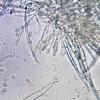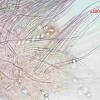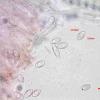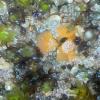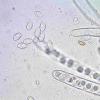
14-11-2024 12:06
 carl van den broeck
carl van den broeck
On November 8th I found very small orange discs st

14-11-2024 15:31
 Bernard CLESSE
Bernard CLESSE
Bonjour à toutes et tous,Que pensez-vous de ce Sc

14-11-2024 04:18
 Götz Palfner
Götz Palfner
Dear community, is this Nemania carbonacea? Micros

14-11-2024 00:34
• Apothecia with predominantly yellow or brown h

11-11-2024 23:17
• Macro and habitat suggest Hyaloscyphaceae s.l.

13-11-2024 08:01
 Stephen Martin Mifsud
Stephen Martin Mifsud
I am revising some old material again and I have t

09-11-2024 16:41
 Stephen Martin Mifsud
Stephen Martin Mifsud
Hello everyone, we have recently published a paper

11-11-2024 14:05
 Edouard Evangelisti
Edouard Evangelisti
Bonjour le forum, Je sollicite votre avis concern

10-11-2024 19:47
• Macro and habitat suggest Phaeohelotium, confi
Small orange discs but no octospora
carl van den broeck,
14-11-2024 12:06
 On November 8th I found very small orange discs stuck together along the edge of a pond in the Belgian dunes. They were on bare ground near Bryum sp. which is why I thought I was dealing with Octospora s.l.. When examining them with a microscope I saw septate cilia which does not occur in Octospora s.l.. No dung was visible in the area. Operculate ascen, 8-spored operculate ascen, oval to ovate smooth spores 14-16 x 8-9 mu, q = 1.7, paraphyses with capitate head, hyaline septate cilia at the edge (hardly visible with a magnifying glass). 99% of the spores contain one drop. Strange spores can be seen on one photo, but I think this is a contamination. Can anyone point me in the right direction? Thanks!
On November 8th I found very small orange discs stuck together along the edge of a pond in the Belgian dunes. They were on bare ground near Bryum sp. which is why I thought I was dealing with Octospora s.l.. When examining them with a microscope I saw septate cilia which does not occur in Octospora s.l.. No dung was visible in the area. Operculate ascen, 8-spored operculate ascen, oval to ovate smooth spores 14-16 x 8-9 mu, q = 1.7, paraphyses with capitate head, hyaline septate cilia at the edge (hardly visible with a magnifying glass). 99% of the spores contain one drop. Strange spores can be seen on one photo, but I think this is a contamination. Can anyone point me in the right direction? Thanks!
Nicolas VAN VOOREN,
14-11-2024 12:10

Re : Small orange discs but no octospora
Why do exclude an Octospora species?
François Bartholomeeusen,
14-11-2024 17:29
Re : Small orange discs but no octospora
Hoi Carl,
Is there perhaps charcoal nearby, then Neottiella hetieri could be a possibility?
Is there perhaps charcoal nearby, then Neottiella hetieri could be a possibility?
Kind regards,
François
carl van den broeck,
14-11-2024 20:31

Re : Small orange discs but no octospora
I have never identified an Octospora with cilia and the keys do not give me an acceptable species.
carl van den broeck,
14-11-2024 20:34

Re : Small orange discs but no octospora
Thanks Francois! In the meantime I found a key of Moyne of Octospora s.l. and relatives with hairy edges. I think your proposal comes close!
Lieve Deceuninck,
15-11-2024 10:36

Re : Small orange discs but no octospora
En recherchant sur Google 'Octospora et setae', je trouverai Octosporopsis, pour mois inconnu.
Nicolas VAN VOOREN,
15-11-2024 10:43

Re : Small orange discs but no octospora
From a phylogenetic point of view, and also morpholgically, Octosporopsis is different from Octospora (s. lato).
The presence of setae/hairs at the margin is no more a character useful to exclude a species from Octospora s. lato.
Neottiella hetieri must be considered as an Octospora, and "true" Neottiella are associated to Polytrichum.
The presence of setae/hairs at the margin is no more a character useful to exclude a species from Octospora s. lato.
Neottiella hetieri must be considered as an Octospora, and "true" Neottiella are associated to Polytrichum.
carl van den broeck,
15-11-2024 12:53

Re : Small orange discs but no octospora
Thanks for your reactions. On http://www.octospora.de/Ohetieri.htm I find description and pictures that morfological perfectly match my find.
